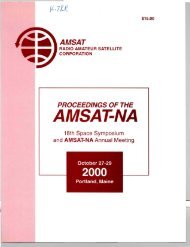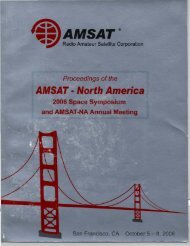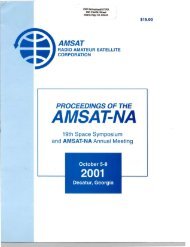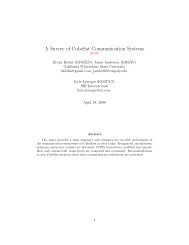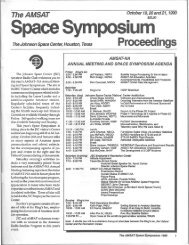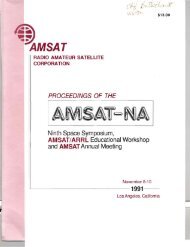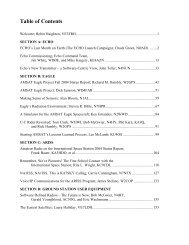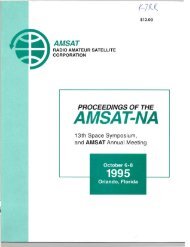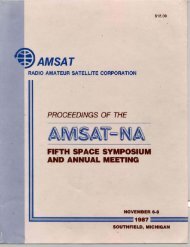CubeSat High-Speed Downlink Communications Update - Klofas.com
CubeSat High-Speed Downlink Communications Update - Klofas.com
CubeSat High-Speed Downlink Communications Update - Klofas.com
You also want an ePaper? Increase the reach of your titles
YUMPU automatically turns print PDFs into web optimized ePapers that Google loves.
<strong>CubeSat</strong> <strong>High</strong>-<strong>Speed</strong> <strong>Downlink</strong><br />
<strong>Communications</strong> <strong>Update</strong><br />
Bryan <strong>Klofas</strong><br />
SRI International<br />
bryan.klofas@sri.<strong>com</strong><br />
Slide 1
CHDC Goals<br />
• Maximize downlink bandwidth and contact time for<br />
science missions<br />
• Lower cost and regulatory burden on PIs<br />
• Establish open knowledge base of NSF-specific<br />
CHDC solutions<br />
Slide 2
CHDC Description<br />
• Provide high-speed data downlinks for future<br />
<strong>CubeSat</strong> NSF missions<br />
– Expandable to all educational missions in the future<br />
• Open standards/interoperable<br />
• Multiple Access<br />
• Meetings:<br />
– Proposed at CEDAR 2009 by Chuck Swenson<br />
– Discussed at SmallSat 2009<br />
– AGU meeting in December 2009 and 2010<br />
• http://groups.google.<strong>com</strong>/group/cubesat-high-speed-downlink<br />
• http://mstl.atl.calpoly.edu/~bklofas/NSF_<strong>com</strong>m/<br />
Slide 3
Out<strong>com</strong>e of last meeting<br />
• Met at AGU last December<br />
• John Malsbury is conducting a survey for NSF<br />
PIs about what they want out of this <strong>com</strong>mittee<br />
– jmalsbury@sparton.<strong>com</strong><br />
• Sara Spangelo is collecting information about<br />
available ground stations and spacecraft<br />
modulations<br />
– saracs@umich.edu<br />
Slide 4
Regulatory Progress<br />
• Electromagnetic Spectrum Management group<br />
at NSF (Tom Gergely and Andy Clegg)<br />
submitted a proposal to place <strong>CubeSat</strong>s on the<br />
agenda for the WRC-15.<br />
– 10 MHz band within 200 to 3000 MHz<br />
– Worldwide basis<br />
– Minimum regulatory burden<br />
• Proposal was blocked by DoD, opposed by FAA,<br />
but had good support from NASA<br />
– Currently being improved by these organizations<br />
Slide 5
Regulatory Progress (2)<br />
• NTIA suggested placing <strong>CubeSat</strong>s on the WRC-<br />
19 agenda, pending successful <strong>com</strong>pletion of<br />
feasibility studies<br />
• Introduce a Study Question in ITU-R Study<br />
Group 7. Studies could eventually lead to an<br />
ITU-R Re<strong>com</strong>mendation<br />
Slide 6
Current Frequency Allocations<br />
Slide 7
Summary of Current Approaches<br />
<strong>Downlink</strong> Spacecraft TX Ground Station RX<br />
RAX<br />
(STP-S26)<br />
FireFly<br />
(Elana4/CRS-2)<br />
FIREBIRD<br />
DICE<br />
(Elana3/NPP)<br />
CINEMA<br />
(Elana6/OUTSat)<br />
CSSWE<br />
437 MHz AstroDev Helium I<strong>com</strong> 910<br />
9600 baud<br />
401 MHz AstroDev Colony-2<br />
145 MHz AstroDev Helium I<strong>com</strong> 910<br />
19200 baud<br />
460 MHz L-3 Cadet USRP<br />
1.5 Mbps<br />
2.2 GHz Emhiser<br />
11m dish<br />
1 Mbps<br />
EDTC-01E1A102-UBC0<br />
437 MHz<br />
9600 baud<br />
SX1231 (all-in-one chip)<br />
Kenwood TS-2000<br />
Slide 8
How to Help<br />
• Comment favorably when the FCC puts out the<br />
<strong>CubeSat</strong> proposal for public <strong>com</strong>ment<br />
• Join the Google Groups<br />
– http://groups.google.<strong>com</strong>/group/cubesat-high-speed-downlink<br />
• Monitor/participate in the work of the US Study<br />
Group 7 (Science Services)<br />
– https://www.ussg7.org/<br />
– Username: sg7User Password: 4webAccess<br />
Slide 9
Thanks<br />
• Thanks for your time<br />
• bryan.klofas@sri.<strong>com</strong><br />
• Backup slides provided by Tom Gergely<br />
Slide 10
National Science Foundation<br />
Frequency Allocations For <strong>CubeSat</strong>s:<br />
Where Does it Stand<br />
Tomas Gergely<br />
Electromagnetic Spectrum Management Unit<br />
National Science Foundation<br />
tgergely@nsf.gov<br />
703-292-4896<br />
<strong>CubeSat</strong> Workshop<br />
Cal Poly<br />
April 22, 2011<br />
11
National Science Foundation<br />
Long Term Goal: Allocated or Designated<br />
Band(s) for <strong>CubeSat</strong> operations (<strong>com</strong>mand,<br />
control and data relay)<br />
Conditions:<br />
• Sufficient bandwidth to ac<strong>com</strong>modate current and<br />
future uses<br />
• Minimum of International Regulatory Obligations<br />
• Uplink (Command and Control) and <strong>Downlink</strong><br />
(Data Relay) in the same band or separate uplink<br />
and downlink bands<br />
12
National Science Foundation<br />
Roadmap<br />
Two possible ways to approach the problem:<br />
• Place Issue on the Agenda of a World Radio<strong>com</strong>munication<br />
Conference (WRC-15 or WRC-19)<br />
• Introduce a Study Question in ITU-R Study Group 7. Studies<br />
could eventually lead to an ITU-R Re<strong>com</strong>mendation<br />
These routes are NOT mutually exclusive. In fact, the first one<br />
would also require ITU-R studies, and the second could<br />
eventually lead to an Agenda Item<br />
13
National Science Foundation<br />
(Some) Difficulties<br />
• No definition of pico or nanosatellites in the ITU. Not a<br />
trivial issue: <strong>CubeSat</strong>s need to be differentiated from<br />
other satellites, so the appropriate regulations (or lack<br />
of them) can be applied to them and ONLY to them<br />
• No adequate explanation why they cannot operate in<br />
existing Space Research, Space Ops or Meteorological<br />
Satellite Bands<br />
• No reliable estimate of required bandwidth (worldwide)<br />
• Some would prefer domestic regulations to precede ITU<br />
action<br />
• In the view of some, the issue is not mature for WRC<br />
action<br />
• Not an exhaustive list!<br />
14
National Science Foundation<br />
The Future Agenda Proposal Route<br />
NSF proposal for a WRC-15 agenda item submitted<br />
to the Radio Conference Sub<strong>com</strong>mittee (RCS) of<br />
the Interdepartment Radio Advisory Committee<br />
(IRAC) – September, 2010<br />
<br />
<br />
Seeks up to 10 MHz of spectrum designated for use by<br />
picosatellite and nanosatellite operations, based on<br />
studies, described in a<br />
Resolution, that urges (mandates) the ITU-R to conduct<br />
studies to identify up to 10 MHz of spectrum for pico<br />
and nanosatellite operations,<br />
In the 200 – 3 000 MHz range<br />
while protecting existing services<br />
on a worldwide basis<br />
with minimum regulatory requirements<br />
15
National Science Foundation<br />
Where Do We Stand?<br />
• The NSF proposal has been repeatedly revised (and<br />
improved) based on NASA, FAA and DoD inputs<br />
• In spite of which the RCS approved only a proposal to<br />
be submitted to WRC-19 on condition that an ITU<br />
Question be submitted to US WP 7B<br />
• Draft proposal sent to the FCC by NTIA (Feb 23, 2011)<br />
• FCC submits proposal to the meeting of sub working<br />
group 3 of the WRC-12 Advisory Committee (WAC) –<br />
March 3, 2011<br />
• Proposal is strongly supported by Boeing, ARRL; but<br />
strongly opposed by Iridium, failing to reach<br />
consensus<br />
• At present the proposal is in the NTIA/FCC<br />
reconciliation process (the prospects for it to make it<br />
are not good)<br />
16
National Science Foundation<br />
•<br />
The Study Question Route<br />
NSF introduced a draft “Study Question in the<br />
appropriate US ITU-R Working Party (US WP 7B)<br />
at the Meeting of March 24, 2011<br />
• Requests for Revisions (Iridium and others)<br />
• Revised “Question” submitted to April 21<br />
meeting.<br />
• If approved in the US, draft study question is<br />
sent to ITU as a US contribution<br />
17
National Science Foundation<br />
How You Can Help ?<br />
• File <strong>com</strong>ments with the FCC. See:<br />
http://www.fcc.gov/Daily_Releases/Daily_Business<br />
/2011/db0127/DA-11-156A1.pdf<br />
• The Nanosat proposal may be found in<br />
Attachment 2 of the above public notice<br />
• You may also write, expressing support to:<br />
Alexander.Roytblatt@fcc.gov<br />
• Participate in the work of US WP 7B . See:<br />
http://www.ussg7.org<br />
Username: sg7User ; Password: 4webAccess<br />
Next meeting is May 26, 1:30 PM (see website for<br />
details)<br />
18



